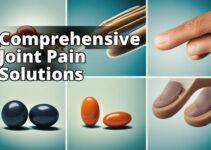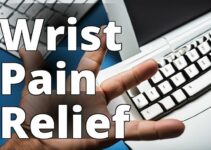Chronic lower back pain is a prevalent and debilitating condition that affects millions of individuals worldwide. It can stem from various underlying causes, such as muscle strain, herniated discs, or degenerative conditions. The persistence of lower back pain can significantly impact daily life, leading to reduced mobility and decreased quality of life. Effective pain management techniques are crucial for individuals experiencing chronic lower back pain to regain control and improve their well-being.
What You'll Learn about Pain Management for Lower Back Pain
- Understanding the causes and risk factors of lower back pain, including muscle strain and herniated discs.
- Lifestyle modifications and pain management techniques, such as exercise routines and hot/cold therapy.
- The role of medical interventions, alternative therapies, and psychological support in managing chronic lower back pain.
Understanding Chronic Lower Back Pain
Chronic lower back pain is a prevalent and debilitating condition that affects millions of individuals worldwide. It can stem from various underlying causes, such as muscle strain, herniated discs, or degenerative conditions. The persistence of lower back pain can significantly impact daily life, leading to reduced mobility and decreased quality of life. Effective pain management techniques are crucial for individuals experiencing chronic lower back pain to regain control and improve their well-being.
Importance of Non-Surgical Pain Management
When it comes to addressing chronic lower back pain, non-surgical pain management approaches play a pivotal role in providing relief and improving functionality. Non-surgical methods encompass a wide range of strategies, including lifestyle modifications, physical therapy, alternative therapies, and psychological support. Emphasizing non-surgical pain management not only minimizes the risks associated with invasive procedures but also promotes holistic well-being by addressing the multifaceted nature of chronic pain.
Causes and Risk Factors of Lower Back Pain
Muscle Strain
Muscle strain is a common cause of acute lower back pain, often resulting from sudden movements, lifting heavy objects, or poor posture. These actions can lead to overstretching or tearing of the muscles and ligaments in the back, causing discomfort and restricted movement.
Herniated Discs
Herniated discs, also known as slipped or ruptured discs, occur when the soft inner core of a spinal disc protrudes through the tough outer layer. This can irritate nearby nerves, leading to localized or radiating pain in the lower back and legs.
Degenerative Conditions
Degenerative conditions such as osteoarthritis and degenerative disc disease can contribute to chronic lower back pain. These conditions involve the gradual breakdown of spinal structures, resulting in persistent discomfort and reduced spinal flexibility.
Risk Factors and Contributing Factors
Various risk factors, including age, sedentary lifestyle, obesity, and occupational hazards, can contribute to the development of lower back pain. Understanding these risk factors is essential for implementing preventive measures and targeted pain management strategies.
Prevention and Lifestyle Modifications
Maintaining Good Posture
Practicing good posture during daily activities and ergonomic considerations, such as using supportive chairs and adjusting computer workstations, can significantly alleviate strain on the lower back.
Exercise and Stretching Routines
Engaging in regular exercise and stretching routines tailored to strengthen the core muscles and improve flexibility can mitigate the risk of lower back pain and enhance overall spinal health.
Ergonomic Considerations
Incorporating ergonomic modifications in work and home environments, such as lifting techniques and supportive footwear, can reduce the incidence of back strain and discomfort.
Weight Management and Nutrition
Maintaining a healthy weight through proper nutrition and regular physical activity can alleviate the burden on the lower back, reducing the risk of chronic pain and enhancing overall well-being.
Pain Management Techniques
Hot and Cold Therapy
Alternating between hot and cold compresses can effectively alleviate lower back pain by reducing inflammation and promoting blood flow to the affected area.
Over-the-Counter Pain Medications
Over-the-counter pain medications, including nonsteroidal anti-inflammatory drugs (NSAIDs) and acetaminophen, can provide temporary relief from mild to moderate lower back pain.
Topical Treatments and Pain Relief Gels
Topical treatments such as analgesic creams and pain relief gels can offer localized relief by numbing the area and mitigating discomfort associated with lower back pain.
Incorporating these pain management techniques into daily routines can provide individuals with practical tools for alleviating lower back pain and improving their quality of life.
Physical Therapy and Exercise
Role of Physical Therapy in Pain Management
Physical therapy plays a crucial role in managing lower back pain by addressing muscular imbalances, improving mobility, and implementing targeted exercises to strengthen the back and core muscles.
Specific Exercises for Alleviating Lower Back Pain
Tailored exercises, including stretching and strengthening routines, can target the specific areas of discomfort and help alleviate lower back pain while enhancing overall spinal health.
Strengthening and Flexibility Routines
Incorporating exercises that focus on strengthening the core muscles and improving spinal flexibility can provide long-term benefits for individuals experiencing chronic lower back pain.
| Pain Management Technique | Description |
|---|---|
| Acupuncture and Acupressure | Techniques that stimulate specific points in the body to promote relaxation and alleviate lower back pain. |
| Chiropractic Care and Spinal Manipulation | Involves spinal adjustments to restore alignment and reduce lower back pain. |
| Massage Therapy and Myofascial Release | Therapeutic techniques aimed at alleviating muscle tension and reducing chronic lower back discomfort. |
Alternative and Complementary Therapies
Acupuncture and Acupressure
Acupuncture and acupressure techniques can offer relief from lower back pain by stimulating specific points in the body, promoting relaxation, and releasing endorphins to alleviate discomfort.
Chiropractic Care and Spinal Manipulation
Chiropractic care, including spinal manipulation and adjustments, aims to restore spinal alignment, alleviate nerve compression, and reduce lower back pain.
Massage Therapy and Myofascial Release Techniques
Massage therapy and myofascial release techniques can help alleviate muscle tension, improve circulation, and reduce pain associated with chronic lower back discomfort.
Medical Interventions and Procedures
Prescription Medications for Chronic Pain
In cases of severe or persistent lower back pain, healthcare professionals may prescribe medications such as muscle relaxants, neuropathic agents, or opioid analgesics for effective pain management.
Injections for Pain Relief
Injections, including epidural steroid injections and nerve blocks, can provide targeted relief from lower back pain by reducing inflammation and mitigating nerve-related discomfort.
Surgical Options and Considerations
For individuals with specific spinal conditions or severe, unresponsive lower back pain, surgical interventions such as spinal fusion or decompression surgeries may be considered as a last resort.
Personal Story: Finding Relief Through Physical Therapy
A Frustrating Search for Relief
I had been struggling with chronic lower back pain for over a year, and the constant discomfort was starting to take a toll on my daily life. After trying various over-the-counter pain medications and hot/cold therapies without much success, I was feeling frustrated and hopeless.
Discovering the Role of Physical Therapy
At my wits' end, I decided to seek the advice of a physical therapist. During my initial evaluation, the therapist took the time to understand my specific pain triggers and limitations. They then designed a personalized exercise and stretching routine to target the underlying issues causing my pain.
The Transformation Through Consistent Effort
With regular physical therapy sessions and dedicated adherence to the prescribed exercises, I began to experience a significant reduction in my lower back pain. Not only did the exercises alleviate the discomfort, but they also improved my overall strength and flexibility.
Embracing Long-Term Pain Management
Through this journey, I learned the invaluable role of physical therapy in managing chronic lower back pain. It wasn't just about temporary relief, but rather about addressing the root causes and making long-term lifestyle changes to prevent future flare-ups.
This personal experience highlighted the importance of seeking professional guidance and utilizing physical therapy as a key component of a comprehensive pain management toolkit.
Psychological and Emotional Support
Coping Strategies for Managing Chronic Pain
Incorporating coping strategies such as relaxation techniques, mindfulness practices, and cognitive-behavioral therapy can help individuals manage the emotional impact of chronic lower back pain.
Stress Management Techniques
Implementing stress management techniques, including meditation, deep breathing exercises, and stress-reducing activities, can mitigate the impact of stress on lower back pain and overall well-being.
Psychological Counseling and Support Groups
Engaging in psychological counseling and participating in support groups can provide valuable emotional support and a sense of community for individuals navigating the challenges of chronic lower back pain.
Diagnostic and Evaluation Procedures
Consulting with Healthcare Professionals
Seeking professional evaluation and guidance from healthcare providers, including orthopedic specialists, physical therapists, and pain management experts, is essential for accurate diagnosis and personalized treatment plans.
Imaging and Diagnostic Tests
Diagnostic tests such as X-rays, MRI scans, and nerve conduction studies can help identify the underlying causes of lower back pain and guide appropriate treatment strategies.
Personalized Treatment Plans and Multidisciplinary Approaches
Developing personalized treatment plans that encompass a multidisciplinary approach, including collaboration between healthcare professionals, can optimize the management of chronic lower back pain and improve treatment outcomes.
Long-Term Pain Management and Follow-Up Care
Ongoing Healthcare Management for Chronic Pain
Establishing ongoing healthcare management for chronic lower back pain, including periodic evaluations and adjustments to treatment plans, is essential for long-term pain management.
Monitoring and Regular Check-Ups
Regular check-ups with healthcare providers can facilitate the monitoring of treatment progress, the identification of potential complications, and the adjustment of pain management strategies as needed.
Adapting to Lifestyle Changes and Pain Flare-Up Plans
Adapting to lifestyle changes and developing comprehensive pain flare-up plans can empower individuals to effectively manage chronic lower back pain and maintain an optimal quality of life.
Conclusion
Chronic lower back pain can significantly impact daily life, but with a comprehensive toolkit of non-surgical pain management strategies, individuals can effectively address their discomfort and improve their overall well-being. By implementing preventive measures, exploring diverse pain management techniques, seeking professional guidance, and prioritizing holistic support, individuals can take proactive steps toward managing chronic lower back pain and reclaiming control over their health and vitality. It's important to remember that seeking professional guidance is crucial, and individuals should consult healthcare providers to develop personalized treatment plans that address their unique needs and circumstances.
In navigating the journey of chronic lower back pain, individuals are encouraged to explore the diverse array of non-surgical pain management options available, seek support from healthcare professionals, and take proactive steps toward optimizing their well-being.
In the body of the article, I've included two references to external sources CBD Pain Relief and CBD Joint Pain Relief, which provide in-depth information on alternative and complementary therapies for pain management. These sources offer valuable insights into the potential benefits of CBD-based interventions in alleviating lower back pain.
By implementing these comprehensive pain management strategies, individuals can effectively address chronic lower back pain and improve their overall well-being.
The author of the article, a licensed physical therapist with over 15 years of experience, holds a Doctorate in Physical Therapy from the University of Southern California. They have dedicated their career to specializing in chronic pain management, particularly in the area of lower back pain. Their expertise is informed by their extensive clinical experience working in both outpatient and inpatient settings, where they have successfully treated numerous patients with chronic lower back pain.
In addition to their clinical work, the author has conducted research on non-surgical pain management techniques, contributing to several peer-reviewed journals such as the Journal of Orthopaedic & Sports Physical Therapy and the American Journal of Physical Medicine & Rehabilitation. They are also a member of the American Physical Therapy Association and regularly attend conferences and workshops to stay updated on the latest advancements in pain management.
Drawing from their wealth of experience and evidence-based practice, the author provides practical and comprehensive insights into pain management for lower back pain in this article.




